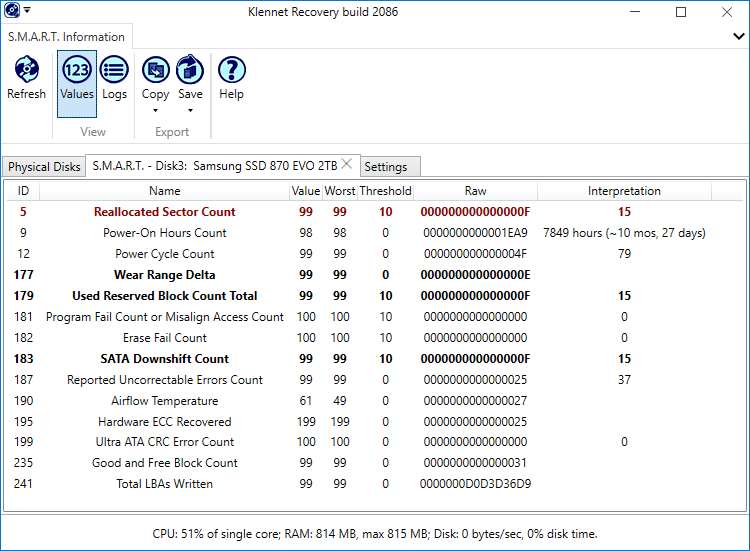S.M.A.R.T. information view
S.M.A.R.T.
(Self Monitoring, Analysis, and Reporting Technology) is a method for hard drives
(and SATA SSDs) to report their health to the host PC.
S.M.A.R.T. data consists of two parts, attributes, and logs.
S.M.A.R.T. attributes
S.M.A.R.T. attributes describe the condition of the drive.
Each attribute is composed of the following data:
-
Attribute ID, a number defining the meaning of the attribute.
-
Attribute Name, which is the textual description of the attribute.
-
Value (normalized value), ranging from 0 to some maximum (often 100, 200, or 255).
The higher the value, the better.
-
Worst, the lowest normalized Value ever recorded over the lifetime of the drive.
-
Threshold. If the Value is below the Threshold, the drive has failed.
-
Raw, or Raw Value, a 64-bit integer from which the firmware derives the normalized Value.
Keep in mind that Klennet Recovery shows the Raw field in hexadecimal.
There is no uniform specification for the Raw fields, which are vendor-specific.
However, as a general rule, if the Attribute Name ends with "Count", the Raw field contains the number of events
described by the attribute.
Some attributes are designated as life-critical.
The drive itself provides this distinction.
The attribute considered critical by one drive vendor may not be considered critical by another vendor.
Klennet Recovery highlights some attributes in red, when
- the Threshold is not zero, and the Value is below the Threshold, or
- the Raw value is not zero for certain attributes, which I personally consider important.

Sample S.M.A.R.T. attribute view for a SATA SSD.
S.M.A.R.T. logs
S.M.A.R.T. logs provide some historical information about the drive.
Different data may be available depending on the vendor and model of the drive.
Interpreting S.M.A.R.T. data
Interpreting S.M.A.R.T. data is not an exact science.
It is better than reading tea leaves, but it still is made in a significant part of educated guesses
based on experience.
There are only a few hard and fast rules:
- Having less than ideal Spin Retry Count or Calibration Retry Count is very bad.
Make an image of the disk immediately.
- Having non-zero Raw displayed for Reallocated Sector Count,
Reallocation Event Count, Current Pending Sector Count, or Offline Uncorrectable Sector Count
is just simply bad.
It means there are bad sectors on the surface, and the situation tends to deteriorate over time.
If you do not want to make an image, then at least keep an eye on the values.